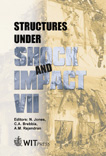Iterative Experimental / Numerical Procedure For Improvement Of Dynamic Experimental Facilities
Price
Free (open access)
Transaction
Volume
63
Pages
10
Published
2002
Size
562 kb
Paper DOI
10.2495/SU020111
Copyright
WIT Press
Author(s)
G Haugou, J Fabis, B Langrand, E Deletombe & E Markiewicz
Abstract
Onera performs dynamic tests for material and assembly characterization using a high velocity hydraulic jack. When the impact velocity increases, the device is disturbed by a natural frequency (around 5kHz). As a consequence, oscillations appear on experimental responses (mainly for the load), measurements cannot be used directly, and the operating range is limited to [0, 100s-l] for strain rates. Today, Onera uses filtering techniques to improve the operating range and measure mechanical properties over a maximum of strain rate range. Nevertheless, the tools may be ineffective for high velocity impact tests. The paper deals with an original method to throw natural frequencies out of the experimental device used for dynamic characterization. It is based on an experimental and numerical modal analysis of each part of the device. A shock hammer and Nastran FE code are used for the experimental and numerical stages respectively. A numerical sensitivity study is carried out regarding the material properties and the geometry of each part of the dynamic facility. The aim is to identity the most sensitive parameters in order to increase the natural frequencies of the device. Mesh size and type of finite elements are also considered. Finally a satisfactory agreement is found between numerical and experimental results and a numerical optimization exercise is performed.
Keywords





